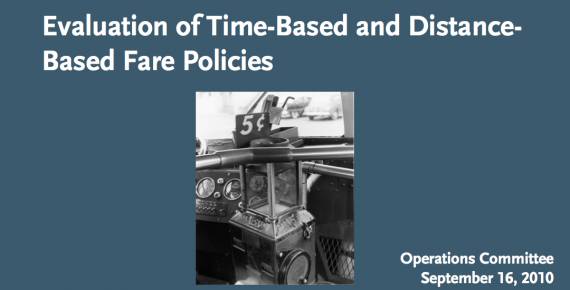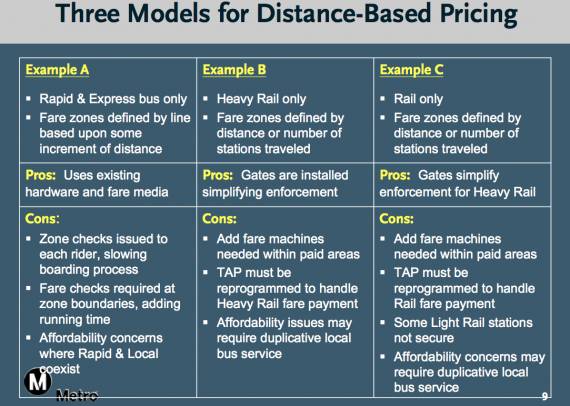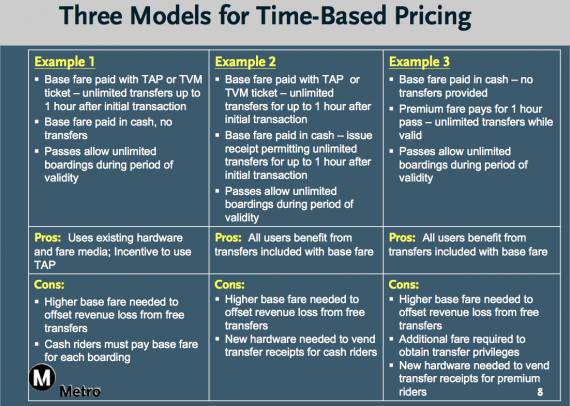Metro Taking a Look at New Fare Models
12:40 PM PDT on September 15, 2010

Editor's note: I emailed a group of transit advocates to get their reactions to this story. Only Kymberleigh Richards responded. She's quoted below, and her full statement can be read here.
Finally, Metro's fascination with installing fare gates at rail stations, despite near universal ridicule for the project, is starting to make sense.
Tomorrow, another four Metro Board Committees will meet, the Management and Audit Committee, the Operations Committee, the Construction Committee and the Ad-Hoc Sustainability Committee. While all of these committees have something interesting on the agenda, what could have the greatest impact on transit rider's future is an initial report on options to change Metro's fare collection system to a "distance based" or "time based" system instead of the current one. A change could be coming sooner than we think. Staff is promising a potential fare structure for the October/November Board Meeting cycle.
You can read the full report here, or the abbreviated handout here.
It should be noted that this report is just a look at other "distance" and "time" based systems around the country and does not contain details on what some of the costs would be for Metro to install the hardware to make such a change or what the new fare structure might look like.
Before we even get into the details, there are already some political road blocks to such a change. Kymberleigh Ricards, of the Southern California Transit Advocates and a Member of the San Fernando Valley Governance Council, notes a major issue with a "distance based fare" structure:
Page 8 of the staff report has everything you need to see to know that Metro cannot create distance-based fares. We know that there are a lot of passengers who are caught in the economic crunch. These passengers will use the lowest-cost option because their budget doesn't allow the extra expense. Trying to create distance-based fares on rail will result in a higher use of parallel bus services that do not carry the distance-based premium, and that will mean whatever additional revenue the rail system brought in would be eaten up by the cost of increasing the parallel service to handle the higher ridership forced onto it.
Time based fares would face another major political problem. Because most time-based fares allow people to ride any service for an hour before needing to reload, it would eliminate the cost of transfers. In other words, people making short trips would actually end up paying more, as the base fare increased to meet the lost revenue from the transfers. I can't imagine that sitting well with a lot of activists, including the Bus Riders Union.
Of course, Metro will also bring on increased costs to make distance based fares a reality. Unless the benefits would only be available to TAP Card holders, which is an option their examining, new machinery would have to be made available at rail stations and on buses. Given the debacle, and cost over-runs, with the installation of the fare gates at Metro rail stations it's hard to see staff getting too excited about another retrofit to the rail stations.
Or, as Richards put it:
An "add fare" machine in the paid area is, in effect, a second set of TVMs at each station. The gating already has cost more (and will continue to cost more) than the additional revenue it brings in; the "add fare" will carry an additional infrastructure cost that will not pay for itself in a reasonable amount of time.
For more on what the report actually says, read on after the jump.

You can see there are three different models for distance based pricing with three different "pro's" and "cons." There are issues that would have to be addressed for any of the plans, including the ones listed above.
However, for Example A there's another major issue. If Distance-Based Pricing becomes the standard for the Rapid Bus System, then all of a sudden Metro is charging different rates to go the same distance on a rapid versus a regular bus along the same route. Also, fare checks in the middle of a ride could end up negating any time saving benefit of the Rapid. Either way, you're going to end up with unhappy transit riders.
In Example C, a major issue would be the existing light rail stations that "aren't secure." For this to work, a major redesign would be in the works.

Each of these examples list the higher base fare, which would in effect be a fare hike for a lot of Metro users and would be considered a poisonous provision to groups that are already fighting traditional fare increases. You can also see that two of the three examples also call for major increases in infrastructure. I can't imagine how a Board Meeting would go where there's a direct relationship between increased base fares and costly new infrastructure for the stations.
Unlike the other previews, this time there will be follow-up either tomorrow or Friday to let you know how the discussions went. If this moves forward, it could be a game-changer for the way millions of people commute.
Stay in touch
Sign up for our free newsletter
More from Streetsblog Los Angeles
Metro Committee Approves 710 Freeway Plan with Reduced Widening and “No Known Displacements”
Metro's new 710 Freeway plan is definitely multimodal, definitely adds new freeway lanes, and probably won't demolish any homes or businesses
Automated Enforcement Coming Soon to a Bus Lane Near You
Metro is already installing on-bus cameras. Soon comes testing, outreach, then warning tickets. Wilshire/5th/6th and La Brea will be the first bus routes in the bus lane enforcement program.




